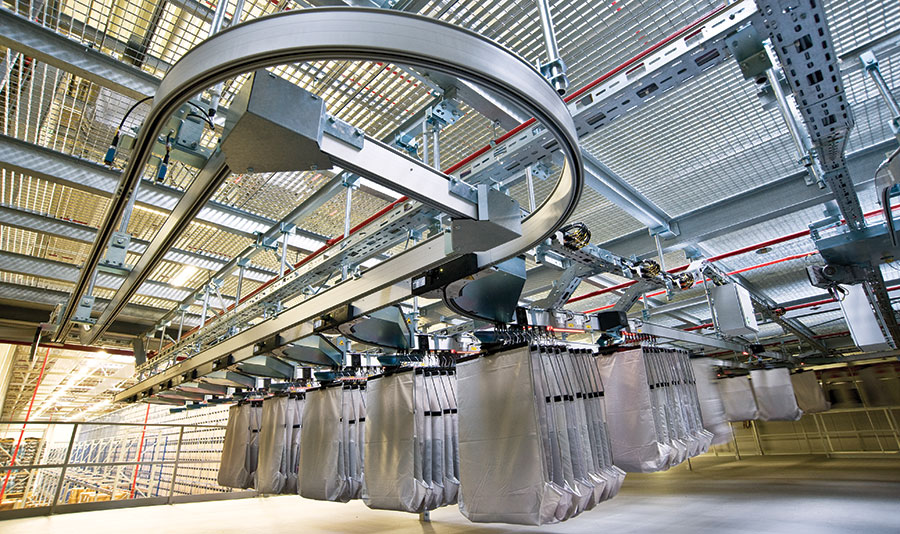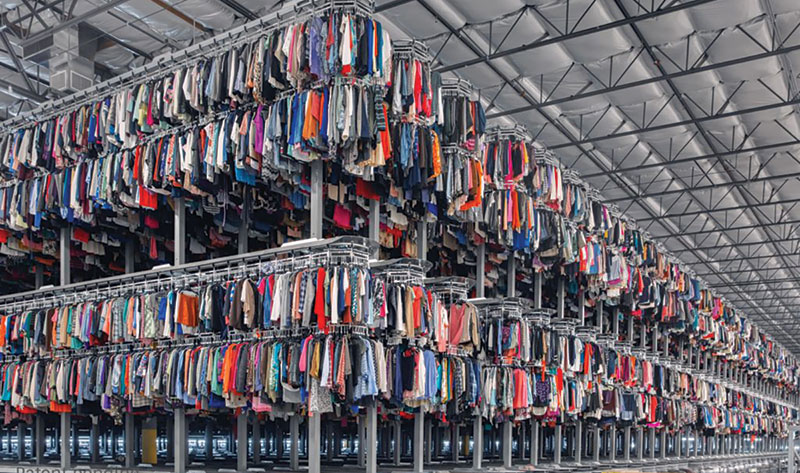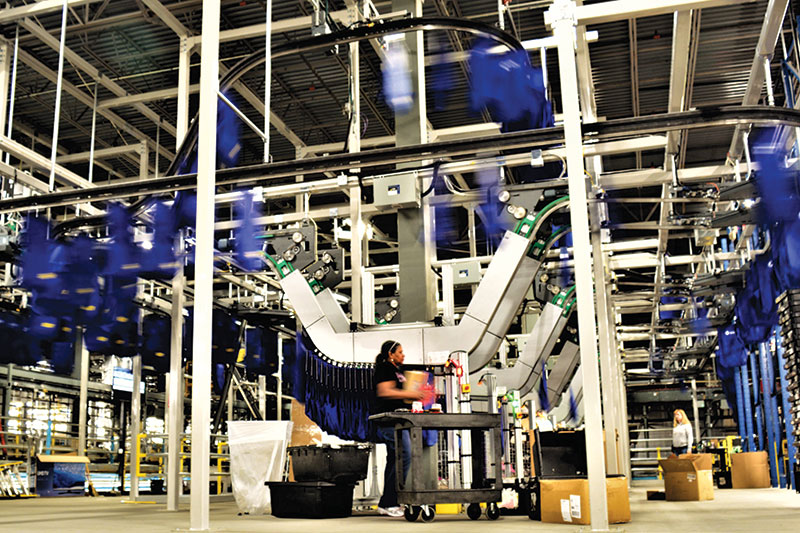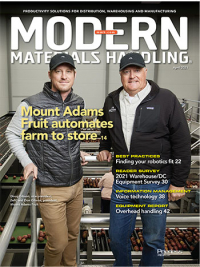Overhead handling: Getting fulfillment up off of the floor
E-commerce sales are booming and warehouse space is expensive and hard to find. Here’s how creative companies can make the most out of their unused overhead space.
With warehouse space selling at a premium and e-commerce sales booming, companies are scrambling to make the best use of their existing footprints. For help, some warehouse managers are looking upward at the unused areas that sit above their machinery, racks, pack stations and employees. When leveraged the right way, this vertical space can become liquid gold for busy DCs and warehouses.
Using garments-on-hanger systems, pouch sorters, pocket sorters and other equipment, organizations can make use of overhead space that would otherwise go to waste. Particularly good for storing, buffering, staging and picking lighter items (for example, garments and goods sold through e-commerce), overhead systems provide a space-efficient way to improve efficiency, safety and throughput in the fulfillment center.
Overhead pocket sortation
Overhead pocket sortation is one option that companies are exploring and investing in. That’s likely because it doesn’t take up any valuable floor space, but it also merges storage, transport and sorting into a single system. Not all items can be handled overhead with these systems, but they are especially useful in certain applications—particularly e-commerce.
“Pocket sortation is generally used for smaller, lighter items,” says Kevin Reader, KNAPP’s director of business development and marketing. “It helps maximize vertical space and can be used as a buffer, for a receiving/returns operation, or to augment order picking and staging prior to pack out.”

Overhead pocket sortation is one option that companies are exploring and investing in.
KNAPP’s pocket sortation equipment uses sophisticated sortation algorithms that enable the picking of items in any order and in any sequence. From there, the items can be buffered and assigned to an order—all while those goods are still “up in the air” and just in time—then delivered in a precise, pack out sequence for multi-line orders at a specific packing station.
When combined with shuttle technology, existing racking or picking equipment, overhead pocket sorters help to “drive e-commerce efficiency much higher,” according to Reader. “You can batch-pick order items, automate sequencing from shuttles, and use one-touch handling, all of which may significantly reduce the need for order-picking and pack-out labor—and significantly reduce the variable cost per order.”
Better productivity and efficiency
Handling materials overhead helps improve productivity, safety and ergonomics while also maximizing available floor space. When operations match the right equipment with the right application, companies can safely lift product, move it efficiently, buffer it, sort it and store it with a minimal number of human touches.
This selling point became particularly attractive for companies in 2020, when the global pandemic forced companies to think about proper social distancing and other Covid-related requirements. “Companies are looking for ways to touch products less for obvious reasons,” Reader points out.
The same organizations are dealing with an e-commerce boom that’s producing a higher number of smaller orders. This “perfect storm” is pushing more of them to turn to overhead materials handling strategies. “Companies always wanted flexible, resilient solutions that can be deployed in different ways,” says Reader, “but Covid made that a top-line issue for many corporate boards.”
Garment-on-hanger solutions
Accumulating, sorting and transporting high volumes of garments is a big task that requires much planning and orchestration. With more consumers buying clothing online right now, it also presents new opportunities for e-commerce companies and third-party logistics (3PL) firms that have the right equipment in place to manage the process. Using overhead conveyors, for example, organizations can store and manage high volumes of garments while maximizing available space and ensuring good customer service levels.
“Overhead conveyor systems let you accumulate and transport garments quickly,” says Charlotte Girod, director of sales at Planiform, whose automated system optimizes the processing garments-on-hanger (GOH) so that workflows run smoothly and orders are filled accurately. The systems push bundles of garments into an induction zone, where a conveyor clip grabs them one hanger at a time.
This year, Girod is seeing an increased interest in both GOH and pouch sorters, the latter of which are being used by makeup companies, food and beverage firms, shoe manufacturers and distributors, and other organizations. “Pouch sorting is pretty versatile and can really touch any type of industry,” says Girod. “It maximizes overhead space and existing warehouse footprints at a time when such space is expensive and difficult to find in the United States.”
Right now, Girod says Planiform’s customers are asking for more automated systems to help offset their ongoing labor woes. Good at handling manual, repetitive tasks, automated overhead handling systems can help fill that gap, enable good social distancing among employees, and also provide a quick return on investment (ROI). And while the push to automate more DC functions was in effect long before Covid, the pandemic has accelerated that trend.
Responding to these demands, Planiform opened an Innovation Center in early 2020 staffed with a team of engineers that are now developing new products focused on solving customers’ problems. Some of those new products will be introduced this year.
Tailor-made solutions
With the average U.S. warehouse now 34 years old, most that were built prior to the mid-2000s are inadequate for e-commerce distribution and are plagued by low ceilings, small footprints, uneven floors and inadequate docking, according to real estate services and investment firm CBRE. These facilities may have sufficed pre-Covid, when e-commerce sales were rising at a fairly steady pace year-over-year.
With worldwide retail e-commerce sales growing 27.6% to $4.3 trillion in 2020 and on track to increase by about 14.3% in 2021, according to a recent eMarketer report, fulfillment centers are balancing a larger number of SKUs with the need to provide accurate, fast fulfillment from their aging facilities. To cope, companies are finding new ways to leverage existing assets, optimize them with new equipment, and infuse automation in a way that helps improve throughput, enhance safety and meet customer demands.
None of this is easy, but overhead materials handling systems may take some of the pressure off. Retailers that built their warehouses to manage store distribution, for instance, are installing unit or package sorters that help them “lift” some of their fulfillment operations up off of the ground while also automating those activities.
“Retailers are tailoring their operations for e-commerce and looking for new ways to handle online orders within their existing footprints,” says Jatin Lewis, senior sales consultant at SDI, whose product lineup includes pouch sorters, tilt-tray sorters, bomb bay-style unit sorters, and cross-belt sorters. Over the last 12 months, Lewis has seen an uptick in demand from retailers looking to blend these and other overhead options into their warehouses and distribution centers.
Lewis says SDI is also making headway in the robotics space, where its ENZO automatic guided vehicle helps optimize storage density while improving putaway and picking productivity. “That’s one of our goods-to-person solutions,” says Lewis, who is seeing high demand for solutions that support omni-channel distribution. Other companies want equipment that can be used across their wholesale, retail and e-commerce operations, effectively allowing multi-purpose usage for a single investment.

Using overhead conveyors, organizations can store and manage high volumes of garments while maximizing available space and ensuring good customer service levels.
Because it can be used for storage and retrieval—or purely for fulfillment—SDI’s pouch system is well suited for e-commerce distribution. “You can utilize overhead space within the warehouse for storage,” says Lewis, “and put the actual stations on the floor so that they’re easily accessible.” The final configuration depends on the individual company, its level of automation, and the volume of orders being processed.
Shopping tips for 2021
Warehouse operators looking to do more with their unused overhead space in 2021 should start by finding a vendor that understands their industry, product mix, how they process orders, their most pressing pain points, and their customer service approach. The supplier that understands these and other nuances will be best-equipped to develop a tailor-made approach for overhead materials handling and/or other systems.
“There are a lot of cookie-cutter options out there, but your best bet is to find a materials handling partner to design a solution that fits your business,” Lewis recommends. “You don’t want to force-feed your business the solution; it should be the other way around.”
With e-commerce sales continuing to climb in the double digits, Lewis says it’s probably also time for retail distribution to stop viewing online orders as a “necessary evil” and to start viewing them as a mainstay that isn’t going to fade anytime soon.
“One thing that the pandemic has taught us is that e-commerce is the way of the future; everything is going digital now,” says Lewis. “Keep that in mind as you grow your business and focus on how to make your systems e-commerce friendly. If you’re designing a storage system, for example, consider how the growth in e-commerce will impact it and what you can do to make it as flexible and scalable as possible.”

Article Topics
Conveyors & Sortation News & Resources
Problem Solved: How a Fulfillment Center Got Back on Track Trew showcases high-throughput modular sortation TrewSort line sorter Coesia acquires AMC, LLC Power Transmission: From horseback to rocket ship Henry Puhl to become the new CEO of TGW Logistics Regal Rexnord to sell its Industrial Motors & Generators businesses to WEG Analyst study: parcel sortation market to top $4 billion by 2030 More Conveyors & SortationLatest in Materials Handling
Geek+ and System Teknik deploy PopPick solution for pharmacy group Med24.dk Beckhoff USA opens new office in Austin, Texas Manhattan Associates selects TeamViewer as partner for warehouse vision picking ASME Foundation wins grant for technical workforce development The (Not So) Secret Weapons: How Key Cabinets and Asset Management Lockers Are Changing Supply Chain Operations MODEX C-Suite Interview with Harold Vanasse: The perfect blend of automation and sustainability Consultant and industry leader John M. Hill passes on at age 86 More Materials HandlingAbout the Author
Subscribe to Materials Handling Magazine

Find out what the world's most innovative companies are doing to improve productivity in their plants and distribution centers.
Start your FREE subscription today.
April 2024 Modern Materials Handling

Latest Resources












